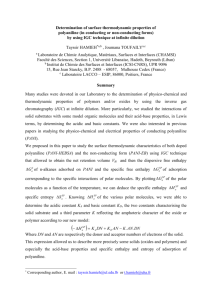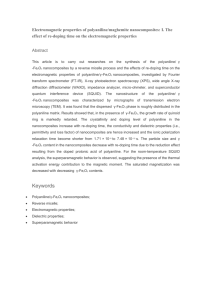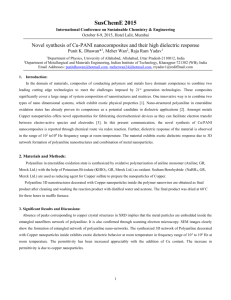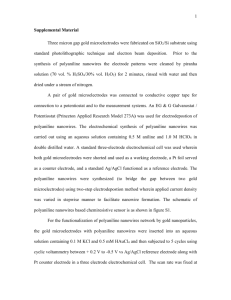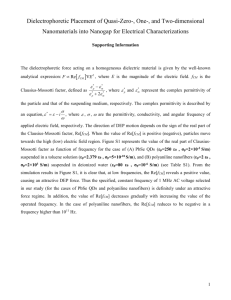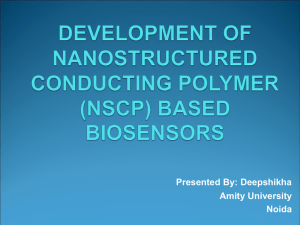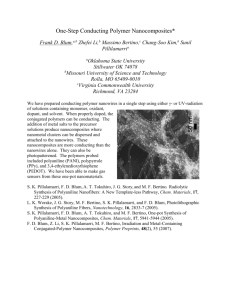The effect of H SO 2
advertisement
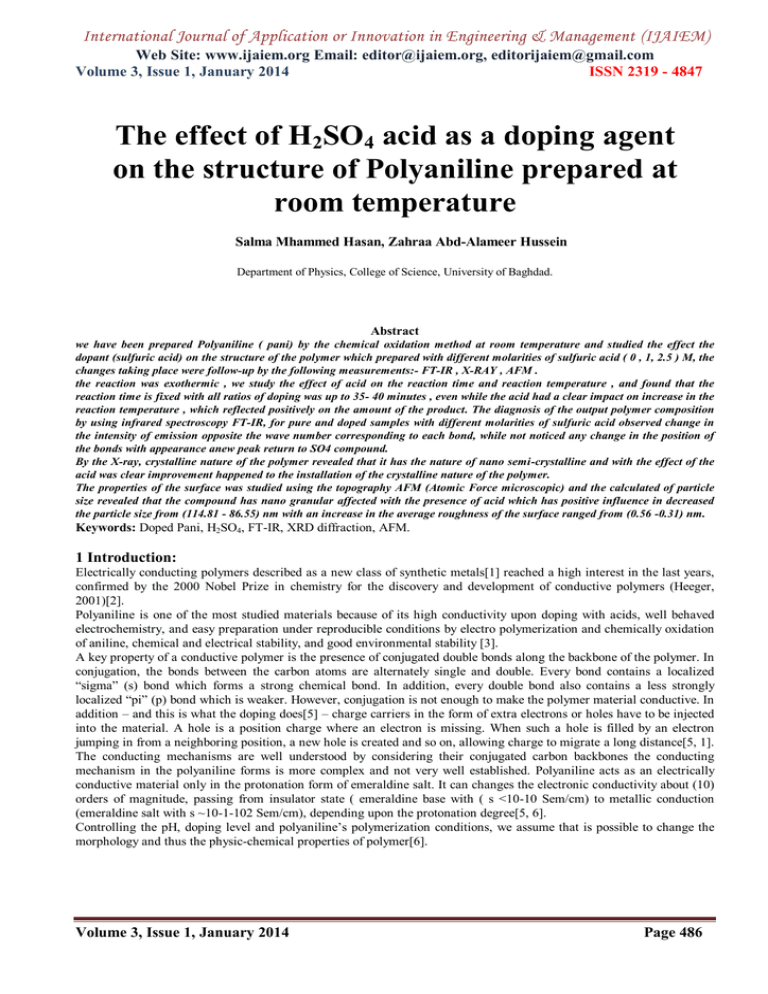
International Journal of Application or Innovation in Engineering & Management (IJAIEM) Web Site: www.ijaiem.org Email: editor@ijaiem.org, editorijaiem@gmail.com Volume 3, Issue 1, January 2014 ISSN 2319 - 4847 The effect of H2SO4 acid as a doping agent on the structure of Polyaniline prepared at room temperature Salma Mhammed Hasan, Zahraa Abd-Alameer Hussein Department of Physics, College of Science, University of Baghdad. Abstract we have been prepared Polyaniline ( pani) by the chemical oxidation method at room temperature and studied the effect the dopant (sulfuric acid) on the structure of the polymer which prepared with different molarities of sulfuric acid ( 0 , 1, 2.5 ) M, the changes taking place were follow-up by the following measurements:- FT-IR , X-RAY , AFM . the reaction was exothermic , we study the effect of acid on the reaction time and reaction temperature , and found that the reaction time is fixed with all ratios of doping was up to 35- 40 minutes , even while the acid had a clear impact on increase in the reaction temperature , which reflected positively on the amount of the product. The diagnosis of the output polymer composition by using infrared spectroscopy FT-IR, for pure and doped samples with different molarities of sulfuric acid observed change in the intensity of emission opposite the wave number corresponding to each bond, while not noticed any change in the position of the bonds with appearance anew peak return to SO4 compound. By the X-ray, crystalline nature of the polymer revealed that it has the nature of nano semi-crystalline and with the effect of the acid was clear improvement happened to the installation of the crystalline nature of the polymer. The properties of the surface was studied using the topography AFM (Atomic Force microscopic) and the calculated of particle size revealed that the compound has nano granular affected with the presence of acid which has positive influence in decreased the particle size from (114.81 - 86.55) nm with an increase in the average roughness of the surface ranged from (0.56 -0.31) nm. Keywords: Doped Pani, H2SO4, FT-IR, XRD diffraction, AFM. 1 Introduction: Electrically conducting polymers described as a new class of synthetic metals[1] reached a high interest in the last years, confirmed by the 2000 Nobel Prize in chemistry for the discovery and development of conductive polymers (Heeger, 2001)[2]. Polyaniline is one of the most studied materials because of its high conductivity upon doping with acids, well behaved electrochemistry, and easy preparation under reproducible conditions by electro polymerization and chemically oxidation of aniline, chemical and electrical stability, and good environmental stability [3]. A key property of a conductive polymer is the presence of conjugated double bonds along the backbone of the polymer. In conjugation, the bonds between the carbon atoms are alternately single and double. Every bond contains a localized “sigma” (s) bond which forms a strong chemical bond. In addition, every double bond also contains a less strongly localized “pi” (p) bond which is weaker. However, conjugation is not enough to make the polymer material conductive. In addition – and this is what the doping does[5] – charge carriers in the form of extra electrons or holes have to be injected into the material. A hole is a position charge where an electron is missing. When such a hole is filled by an electron jumping in from a neighboring position, a new hole is created and so on, allowing charge to migrate a long distance[5, 1]. The conducting mechanisms are well understood by considering their conjugated carbon backbones the conducting mechanism in the polyaniline forms is more complex and not very well established. Polyaniline acts as an electrically conductive material only in the protonation form of emeraldine salt. It can changes the electronic conductivity about (10) orders of magnitude, passing from insulator state ( emeraldine base with ( s <10-10 Sem/cm) to metallic conduction (emeraldine salt with s ~10-1-102 Sem/cm), depending upon the protonation degree[5, 6]. Controlling the pH, doping level and polyaniline’s polymerization conditions, we assume that is possible to change the morphology and thus the physic-chemical properties of polymer[6]. Volume 3, Issue 1, January 2014 Page 486 International Journal of Application or Innovation in Engineering & Management (IJAIEM) Web Site: www.ijaiem.org Email: editor@ijaiem.org, editorijaiem@gmail.com Volume 3, Issue 1, January 2014 ISSN 2319 - 4847 The aspect which attracted our interest is the protonated structure of Polyaniline in the acidic media, Fig.1Polyaniline in its sulfonated form shows a close structure with the ion conducting polymers, where the Inorganic anions are represented by HSO4 - species. In the emeraldine salt (ES), the HSO4 -species are ionically bonded with the - NH groups presented in the polymer chain. Actually, these kinds of bonds are very weak and can be removed very easy by changing the system’s pH[7]. By supplementary doping of polyaniline in sulfuric acid media, actually we introduced multiple charge carriers which determine an improvement of the electrical conduction along the polymer chain. Moreover, we assume that the total conduction in SPANI is given by summing the electrical conduction and ionic conduction that occurs by sulfonic groups on the aromatic rings [7]. Figure.2: The designed transition of electron conducting PANI (ES) to -SO3 doped Polyaniline (SPANI) [7]. 2 Chemical Materials: We have used the following materials for synthesis the Polyaniline. All chemicals used here were of the highest purity available, which their supplier companies and the purpose for used were listed in Table (1). Table (1): Employed chemicals and their supplier companies. 3 Preparation of Polyaniline: Pure and doped Polyaniline salt was prepared at the ambient conditions at room temperature [8]. Three – necked round bottomed flask equipped with a thermometer. Electromagnetic stirrer and condenser were used to polymerize Polyaniline. The preparation of (PANI) is based on the oxidation of (0.2) M aniline hydrochloride with (0.25) M ammonium Volume 3, Issue 1, January 2014 Page 487 International Journal of Application or Innovation in Engineering & Management (IJAIEM) Web Site: www.ijaiem.org Email: editor@ijaiem.org, editorijaiem@gmail.com Volume 3, Issue 1, January 2014 ISSN 2319 - 4847 peroxydisulphate in aqueous medium combined with a different molarities acid of (H2 SO4) with the following ratios (0, 0.5, 1, 1.5, 2.5) M. Both solutions are mixed in a round bottomed flask and gentle stirring to polymerize the mixture. The reaction is found to be exothermic. The temperature as a function of time for this reaction was recorded through the polymerization processes. The mixture was left to rest to the next day. The precipitate (PANI) was collected on filter papers and washed with three 100 ml of (0.2M HCl) and 150 ml of acetone. After that (PANI) was dried in air for one hour and then in vacuum oven at (90°C) for 6 hours, annealed to avoid any effect of moisture absorption. The Polyaniline powder was thoroughly grounded in a mortar to obtain very fine particles. And then the samples were compressed under pressure of (250bar) in the form of disks. Table 2 illustrating the reaction steps by pictures. Table 2: pictures illustration the reaction steps 4 Results and Discussion 4.1 Time of Polymerization The oxidation of aniline was found to be exothermic reaction. The temperature of reaction changes with time of polymerization. Fig.3 shows the reaction temperature with time of polymerization for polyaniline samples for pure and doped polymer at room temperature. From this figure it can distinguish three stages, first stage (induction period), the temperature stays virtually constant, the reaction mixture becomes blue as oligomeric intermediates are produced. When the polymerization has started, the temperature increases, as shown in stage two, when polymerization propagate, the color of the mixture turns to dark green, and the consistency becomes that of a slurry. In stage three the temperature decreases and reaches the saturation, the reaction will be in the termination step (post - polymerization period).The difference in polymerization time is strongly depending on the temperature of used aqueous solution. The room temperature polymerization is completed within 30 minutes. Figure.3: The variation time of polymerization as a function of reaction temperature for pure (C1) and doped Polyaniline (C3, C5) in different acidic ratios of H2SO4. From the Figure above we notice that the reaction of doped Polyaniline in Different moralities of H2SO4 is more active, and that will reflect in the yield point, particle size and electrical conductivity of polymer, the variation of temperature reaction and the yield of polymerized polymer are listed in table 2 . Table 3: The effect of PH ratio on the reaction temperature. Volume 3, Issue 1, January 2014 Page 488 International Journal of Application or Innovation in Engineering & Management (IJAIEM) Web Site: www.ijaiem.org Email: editor@ijaiem.org, editorijaiem@gmail.com Volume 3, Issue 1, January 2014 ISSN 2319 - 4847 From the table 3, we noticed when increasing the molarities of H2SO4 is lead to increasing in reaction temperature, as shown in sample C5, and this increasing reflected on the electrical properties, yield and particle size. T0* = Temperature at which interacting by then began, Tm*=highest temperature interaction has reached to it, T s * = Temperature by then saturation state obtained to the reaction solution, ∆T *=Tm- T0= the difference between Highest temperature of the reaction and the beginning of it 4.2 structural analyses: The molecular structures were characterized by many methods such as, FTIR (Fourier transformation infrared spectroscopy), X-Ray diffraction and AFM (Atomic Force Microscopy). The structural of the main chain and electronic structure are showing simple change in results in both cases of pure and doped aniline, as will be explained below. 4.2.1 Fourier Transform Infrared (FT-IR): FTIR is one of the most common methods of spectroscopy, we were studying the IR spectroscopy of both pure and doped Polyaniline, and this is achieved by comparison of the band position and intensities observed in IR spectra with wave numbers for determining functional groups present in Polyaniline. Infrared spectrum can be affected by several factors in the whole region from (500-4000) cm- such as the influence of different ambient conditions (humidity , temperature and pressure in the sample preparation), storing and processing that take place on the samples .The amount of moisture in the Potassium bromide matrix varied in the individual laboratories . Figure 3 shows the infrared spectrum of the samples prepared at room temperature with different concentrations of acidic, where the percentage of transmittance is plotted as a function of wave number (cm-) .The characteristic of FTIR can distinguish between benzoid rings and quiniod rings in the (1300 -1600) cm- region of the spectrum .This region of the spectrum is very important to distinguish and diagnostics the polymer in both cases of pure and doped [5, 9]. Volume 3, Issue 1, January 2014 Page 489 International Journal of Application or Innovation in Engineering & Management (IJAIEM) Web Site: www.ijaiem.org Email: editor@ijaiem.org, editorijaiem@gmail.com Volume 3, Issue 1, January 2014 ISSN 2319 - 4847 Figure (4): shows the infrared spectrum of the Polyaniline samples (C1, C3, C5) prepared at room temperature with different concentrations of sulfuric acid. The observed peak for the prepared Polyaniline at room temperature with different concentration of H2SO4 list in Table 4 shows the main transmission band of the PANI. The observed peak at 687 cm- is a measure of the amount of chlorine which was returned to the used monomer (aniline hydrochloride). While the peak at 1315 cm-could be related to the aromatic amines in the case of undoped (pure) polymer, but it possible to return to each of the aromatic amines and to sulfate compounds which resulting from the dopant acidic. As well as, for the peak at 1416cm- relating to water and alcohols resulting from the interaction in the case of (pure) undoped, while in the case of doped with sulfuric acid 1409, 1410 cm- can be attributed to a case of sulfate groups attached to the aromatic ring in addition to alcohol as products. The most important characteristic bands installed Polyaniline is the band observed at a wavelength of 1494cm- and the band at 1595 cm-, which represents the benzeniod and quinoid rings, respectively. Finally the other bands which located at the range about (1640 _3400) cm- they presence the vibration bands of water molecules in most of the spectra shown by figure 4 correspond to a higher humidity during measurements that were made [9]. Table (4):- The lists of the observed peak for the prepared Polyaniline at room temperature with different concentration of H2SO4. The intensity of peaks depends on factors such as polymer coil size, the nature of polymer – solvent polymer doping. The intensity of the protonated immense group is sensitive to PH molars of aqueous solution which was used in polymerization and in the increasing of PH concentration, so the change in intensity of IR vibration band confirms the doping interactions with PANI [11]. In Figure 4 With the doped polymer when we comparing it with the standard peaks we notice the change in intensity, no shifting in the position of the band, and the peak for sulfate group were noticed which mean the doping happened in polymer chain . 4.2.2 X-ray Diffraction: there are different opinions in the synthetic nature of Polyaniline, some described as amorphous [12], and another described it as semi crystalline nature [13], but we can say from Figure 5 that pure Polyaniline may be have tinny crystals (micro or nano crystals) embedded in amorphous network .pure Polyaniline shows the broad peak at lower Bragg angle about 2θ =25.38 corresponding to [1 0 0] diffraction plane of Polyaniline [14]. In Figure 5 which shows the X-ray diffraction for pure and doped Polyaniline with different ratios of sulfuric acid. the XRD spectra showed that the addition of H2SO4 has no new diffraction peaks, with a distinct change in the intensity and a new phase created to growth a simple semi -crystalline and its grain size become smaller in size , particularly with the ratio doped of 2.5M of H2 SO4 sample (C5) as shown in Figure 5, and this variation in diffraction intensity with H2SO4 Volume 3, Issue 1, January 2014 Page 490 International Journal of Application or Innovation in Engineering & Management (IJAIEM) Web Site: www.ijaiem.org Email: editor@ijaiem.org, editorijaiem@gmail.com Volume 3, Issue 1, January 2014 ISSN 2319 - 4847 ratio exhibits the interaction of doping with PANI network and the macromolecule began to arranged in smaller grain size as listed in table 5 below . Table 5: lists the effect of acidic and radiation on the grain size and Bragg angle and intensity in Polyaniline samples. Figure 5: the X-Ray diffraction of pure and doped Polyaniline with different concentration of H2SO4 acid. 4.2.3 SEM and AFM study: There are wide range of analytical technical characterization depending on the type of information needed, for high resolution surface investigation, tow commonly used techniques are Atomic Force Microscopic (AFM) and Scanning Electronic Microscopy (SEM). The morphology and particle size of the conducting PANI pure sample was studied by means of a scanning electron microscope. Figure 6 shows the SEM image of PANI nanoparticles. The micrograph was taken at the operating voltage of 15kV and 50,000 times magnification. It reveals the formation of conducting PANI nanostructures distributed almost uniformly and the diameter of spherical PANI nanoparticles was estimated to be in the range of (15.96-63.09) nm. The micrograph also reveals some clusters made up from aggregates of many PANI nanoparticles. The PANI cluster size is about 167.49nm. Figure 6: show the SEM image for the particle size of pure Polyaniline sample C1 prepared at room temperature. Volume 3, Issue 1, January 2014 Page 491 International Journal of Application or Innovation in Engineering & Management (IJAIEM) Web Site: www.ijaiem.org Email: editor@ijaiem.org, editorijaiem@gmail.com Volume 3, Issue 1, January 2014 ISSN 2319 - 4847 AFM analysis for Polyaniline doped in deferent concentration of H2SO4 (0, 1, 2.5)M is shown in Fig.8 (a, b, and c) respectively, We can see that the surface of pure sample is relatively smooth and regular and consists of small cluster with diameters, in the range of 114.81nm, distributed over the scanned area and the roughness of the surface was 0.564nm, these values decreasing with increasing in the concentration of acid, as listed in table 6, from the Fig.8 the formation of conducting PANI nanostructures distributed almost uniformly in spherical shape. The micrograph also reveals some fibrous clusters made up from aggregate of many PANI nanoparticles. This result of the interchain interaction or self association via hydrogen bonding, also there is a less probably possibility of intrachain H-bonding interaction. Table 6: listed the effect of sulfuric acid concentration on the average diameter and roughness. Figure 8 a: average diameter of pure Polyaniline C1 Figure 8 b: average diameter of Polyaniline doped with (1M) H2SO4 C3. Figure 8 C: average diameter of Polyaniline doped with (2.5M) H2SO4 C5. 5 Conclusions:1. The Polymerization reaction of Polyaniline was exothermic reaction. 2. The Reaction temperature and time of polymerization is directly proportional to the amount of acid which used to doping in the aqueous solution. Volume 3, Issue 1, January 2014 Page 492 International Journal of Application or Innovation in Engineering & Management (IJAIEM) Web Site: www.ijaiem.org Email: editor@ijaiem.org, editorijaiem@gmail.com Volume 3, Issue 1, January 2014 ISSN 2319 - 4847 3. The amount of yield output suit directly proportional to the amount of doped acid and the increase in the reaction temperature and time of polymerization. 4. Polyaniline characteristics were treated by many analysis methods such as FT-IR, X –ray and AFM. From these analyses, it can be proved that Polyaniline has nanostructure and chemical stability. 5. The diagnosis of the FTIR Confirmed the internal structure of the polymer. with the presence of acid, the position of the bonds has not changed and we notice anew bonds return to SO2 compound, in a while got a noticeable change in the intensity . 6. The diagnosis of X-rays indicated that the Polyaniline has a semi-crystal structure; however the effect of acid caused an increase in the properties of crystalline and a remarkable decreasing in grain size of the polymer. 7. The diagnostic results of AFM indicated that the particle size of the polymer within the nanoscale and with the presence of acid, the marked improvement in the smallest particle size ranged between (114 –86) nm. References: [1] ''Synthetic Metals: a novel role for organic polymers", A. G. Macdiarmid, Curr. Appl. Phys., (2001), Vol. 1, P. (269–279). [2] "The discovery of polyacetylene film – the dawning of an era of conducting polymers", H. Shirakawa, Curr. Appl. Phys., (2001), Vol. 1, P. (281–286). [3] "Influence of Chemical Polymerization Conditions on the Properties of Polyaniline", Yong Cao, Alejandro Andreatta et al, ELESEVIER polymers, (1989),Vol.30, P.(2305-2311). [4] "Polyaniline: anovel class of conducting polymers", Alan G.MacDiramid and Arthur J.Epstien, Faraday Discuss. Chem. Soc., (1989), Vol.88, P. (317-332). [5] " Acid Doping of Polyaniline: Spectroscopic and Electrochemical Studies", David W.Hatchett, Mira Josowicz et al, Phys.Chem. B, (1999), Vol.103, P. (10992-10998). [6] "Electrochemical doping of Polyaniline: effects on conductivity and optical spectra", Peter M.Mc Manus, Sze Cheng Yang, J. Chem. Soc., Chem. Commun., (1985), Vol.22, P.(1556-1557). [7] "A.C Electrical Conductivity for Polyaniline Prepered in Different Acidic Medium",Salma M. Hassan, Amera Ghareeb Baker, and Harith I. Jafaar, International Journal of Basic and Applied Science,Vol 01, No. 02, Oct 2012, pp. 352-362. [8] "Conducting Polymers Prepared by Oxidative Polymerization: Polyaniline ", N. GOSPODINOVA, L. TERLEMEZYAN, Institute of Polymers, Bulgarian Academy of Sciences, Pergamon, , (1998), Vol. 23, P.(1443– 1484). [9] "Spectroscopic Study of Polyaniline Emeraldine Base: Modelling Approach", Medhat Ibrahima and Eckhard Koglinb, Acta Chim. Slov., 2005, Vol. 52, P.(159– 163). [10] "Polyaniline: The infrared spectroscopy of conducting polymer nanotubes (IUPAC Technical Report) ", Miroslava Trchová and Jaroslav Stejskal, Pure Appl. Chem., 2011, Vol. 83, P. (1803–1817). [11] "Conductive polymer preparation under extreme or non-classical Conduction", W. M. de Azevedo, R. A. de Barros and E. F. da Silva Jr, J Mater Sci ,2008 ,V. 43,P. (1400–1405). [12] "unusual properties of the aniline black: Does the superconductivity exist at room temperature?" J. Langer, Solid State Commun. , 1978, vol. 26, P. 837. [13] "Study on the crystallinity of Polyaniline", Wang Fosong, Tang Jinsong et al, Mol. Cryst. Lig. Cyst. ,1988, Vol. 160, P. (175-184). [14] "X-ray structure of Polyaniline" , J. P. Pouget , M. E. Jozefowicz , A. J. Epstein , X. Tang , A. G. MacDiarmid, Macromolecules, 1991, Vol. 24 , P.(779–789). Volume 3, Issue 1, January 2014 Page 493
